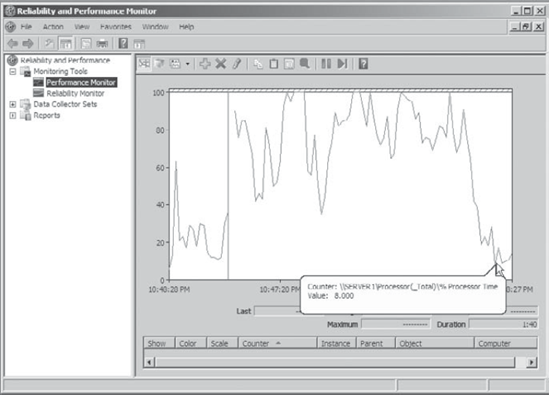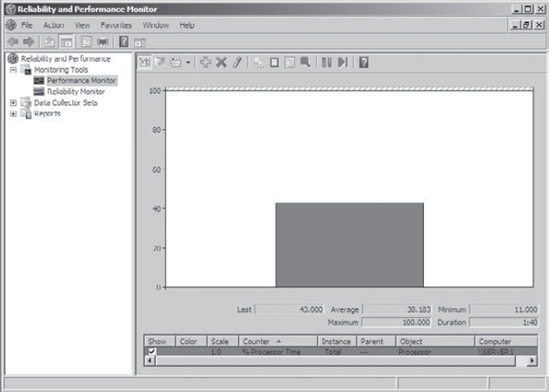2. Viewing Performance Information
The Windows Server 2008 Performance Monitor was
designed to show information in a clear and easy-to-understand format.
Performance objects, counters, and instances may be displayed in each
of three views. This flexibility allows systems administrators to
quickly and easily define the information they want to see once and
then choose how it will be displayed based on specific needs. Most
likely you will only use one view, but it's helpful to know what other
views are available depending on what it is you are trying to assess.
You can use the following main views to review statistics and information on performance:
Graph view
The Graph view is the default display that is
presented when you first access the Windows Server 2008 Performance
Monitor. The chart displays values using the vertical axis and time
using the horizontal axis. This view is useful if you want to display
values over a period of time and or see the changes in these values
over that time period. Each point that is plotted on the graph is based
on an average value calculated during the sample interval for the
measurement being made. For example, you may notice overall CPU
utilization starting at a low value at the beginning of the chart and
then becoming much higher during later measurements. This indicates
that the server has become busier (specifically, with CPU-intensive
processes). Figure 2 provides an example of the Graph view.

|
A quick way to get to the Performance Console and view Performance Monitor is to go to Start => Run and enter perfmon in the Open box. The Performance Console opens directly to Performance Monitor.
|
|
Histogram view
The Histogram view shows performance statistics
and information using a set of relative bar charts. This view is useful
if you want to see a snapshot of the latest value for a given counter.
For example, if we were interested in viewing a snapshot of current
system performance statistics during each refresh interval, the length
of each of the bars in the display would give us a visual
representation of each value. It would also allow us to visually
compare measurements relative to each other. You can set the histogram
to display an average measurement as well as minimum and maximum
thresholds. Figure 3 shows a typical Histogram view.

Report view
Like the Histogram view, the Report view shows
performance statistics based on the latest measurement. You can see an
average measurement as well as minimum and maximum thresholds. This
view is most useful for determining exact values because it provides
information in numeric terms, whereas the Chart and Histogram views
provide information graphically. Figure 4 provides an example of the type of information you'll see in the Report view.
